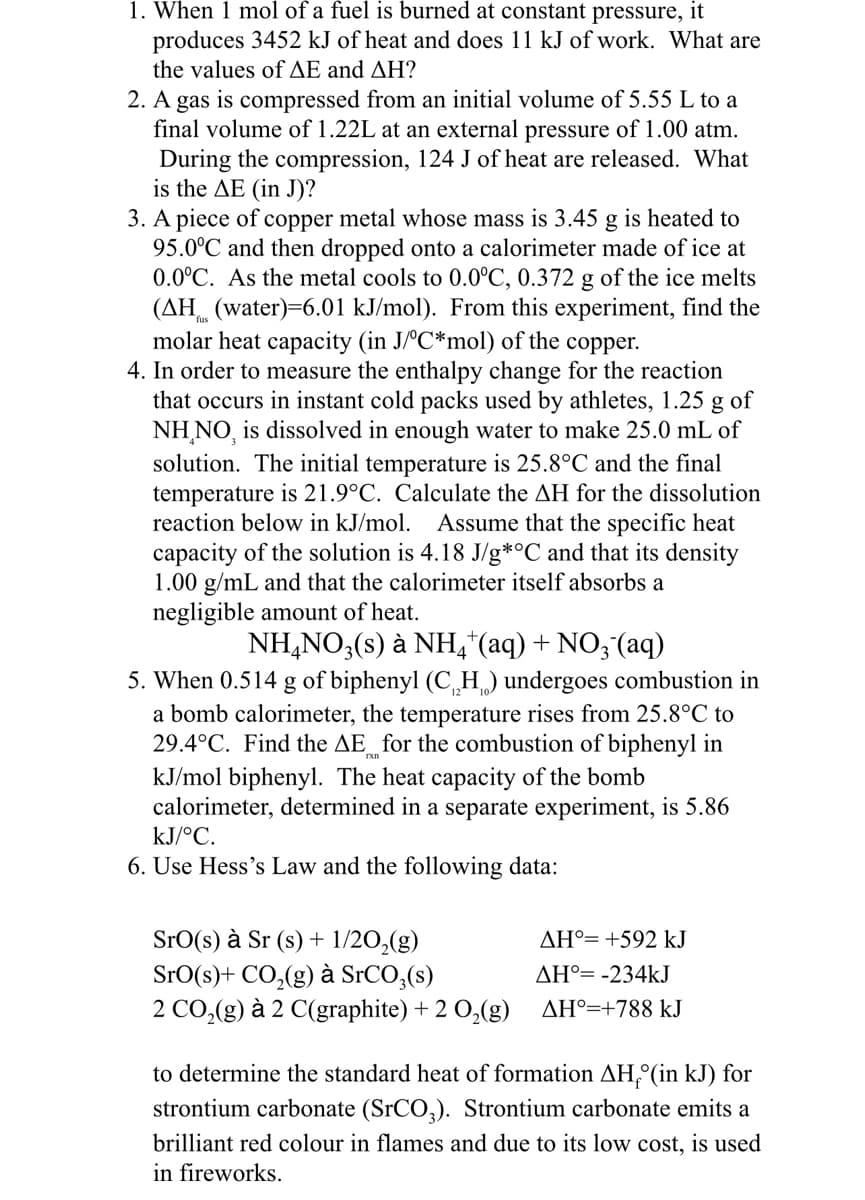6. Use Hess's Law and the following data: Sro(s) à Sr (s) + 1/20₂(g) SrO(s)+ CO₂(g) à SrCO3(s) 2 CO₂(g) à 2 C(graphite) +2 O₂(g) ΔΗ°= +592 kJ AH°= -234kJ AH =+788 kJ to determine the standard heat of formation AH, (in kJ) for strontium carbonate (SrCO3). Strontium carbonate emits a brilliant red colour in flames and due to its low cost, is used in fireworks.
6. Use Hess's Law and the following data: Sro(s) à Sr (s) + 1/20₂(g) SrO(s)+ CO₂(g) à SrCO3(s) 2 CO₂(g) à 2 C(graphite) +2 O₂(g) ΔΗ°= +592 kJ AH°= -234kJ AH =+788 kJ to determine the standard heat of formation AH, (in kJ) for strontium carbonate (SrCO3). Strontium carbonate emits a brilliant red colour in flames and due to its low cost, is used in fireworks.
Chemistry for Engineering Students
4th Edition
ISBN:9781337398909
Author:Lawrence S. Brown, Tom Holme
Publisher:Lawrence S. Brown, Tom Holme
Chapter9: Energy And Chemistry
Section: Chapter Questions
Problem 9.101PAE
Related questions
Question
100%
Can you please answer question 6

Transcribed Image Text:1. When 1 mol of a fuel is burned at constant pressure, it
produces 3452 kJ of heat and does 11 kJ of work. What are
the values of ΔΕ and ΔΗ?
2. A gas is compressed from an initial volume of 5.55 L to a
final volume of 1.22L at an external pressure of 1.00 atm.
During the compression, 124 J of heat are released. What
is the AE (in J)?
3. A piece of copper metal whose mass is 3.45 g is heated to
95.0°C and then dropped onto a calorimeter made of ice at
0.0°C. As the metal cools to 0.0°C, 0.372 g of the ice melts
(AH (water)=6.01 kJ/mol). From this experiment, find the
molar heat capacity (in J/°C*mol) of the copper.
4. In order to measure the enthalpy change for the reaction
that occurs in instant cold packs used by athletes, 1.25 g of
NH.NO, is dissolved in enough water to make 25.0 mL of
solution. Th initial temperature is 25.8°C and the fina
temperature is 21.9°C. Calculate the AH for the dissolution
reaction below in kJ/mol. Assume that the specific heat
capacity of the solution is 4.18 J/g*°C and that its density
1.00 g/mL and that the calorimeter itself absorbs a
negligible amount of heat.
NH4NO3(s) à NH4+ (aq) + NO3 (aq)
5. When 0.514 g of biphenyl (C₂H) undergoes combustion in
a bomb calorimeter, the temperature rises from 25.8°C to
29.4°C. Find the AE for the combustion of biphenyl in
kJ/mol biphenyl. The heat capacity of the bomb
calorimeter, determined in a separate experiment, is 5.86
kJ/°C.
6. Use Hess's Law and the following data:
Sro(s) à Sr (s) + 1/20₂(g)
SrO(s)+ CO₂(g) à SrCO3(s)
2 CO₂(g) à 2 C(graphite) + 2 O₂(g)
AH°= +592 kJ
AH°= -234kJ
AH°=+788 kJ
to determine the standard heat of formation AH (in kJ) for
strontium carbonate (SrCO3). Strontium carbonate emits a
brilliant red colour in flames and due to its low cost, is used
in fireworks.
Expert Solution
This question has been solved!
Explore an expertly crafted, step-by-step solution for a thorough understanding of key concepts.
This is a popular solution!
Trending now
This is a popular solution!
Step by step
Solved in 4 steps with 4 images

Knowledge Booster
Learn more about
Need a deep-dive on the concept behind this application? Look no further. Learn more about this topic, chemistry and related others by exploring similar questions and additional content below.Recommended textbooks for you

Chemistry for Engineering Students
Chemistry
ISBN:
9781337398909
Author:
Lawrence S. Brown, Tom Holme
Publisher:
Cengage Learning

Chemistry
Chemistry
ISBN:
9781305957404
Author:
Steven S. Zumdahl, Susan A. Zumdahl, Donald J. DeCoste
Publisher:
Cengage Learning


Chemistry for Engineering Students
Chemistry
ISBN:
9781337398909
Author:
Lawrence S. Brown, Tom Holme
Publisher:
Cengage Learning

Chemistry
Chemistry
ISBN:
9781305957404
Author:
Steven S. Zumdahl, Susan A. Zumdahl, Donald J. DeCoste
Publisher:
Cengage Learning


Chemistry: An Atoms First Approach
Chemistry
ISBN:
9781305079243
Author:
Steven S. Zumdahl, Susan A. Zumdahl
Publisher:
Cengage Learning

Chemistry & Chemical Reactivity
Chemistry
ISBN:
9781133949640
Author:
John C. Kotz, Paul M. Treichel, John Townsend, David Treichel
Publisher:
Cengage Learning

Chemistry & Chemical Reactivity
Chemistry
ISBN:
9781337399074
Author:
John C. Kotz, Paul M. Treichel, John Townsend, David Treichel
Publisher:
Cengage Learning